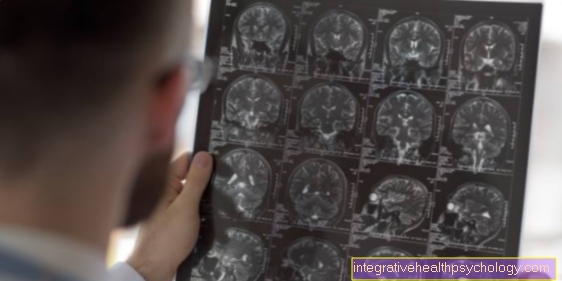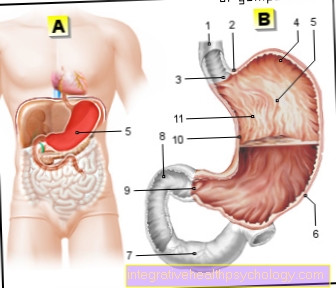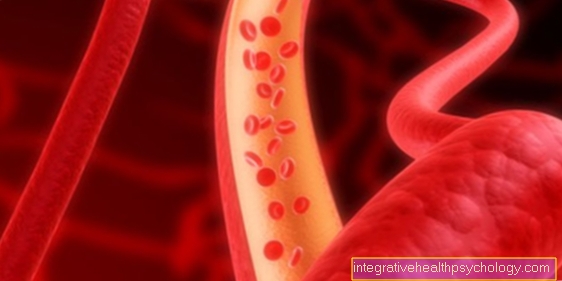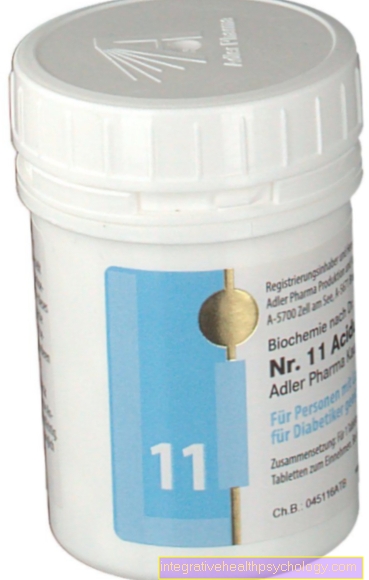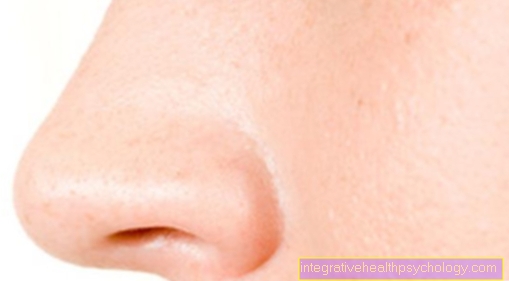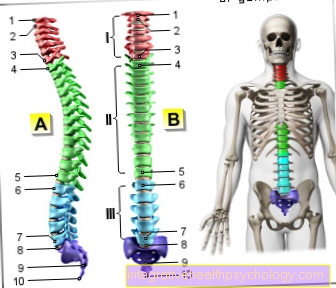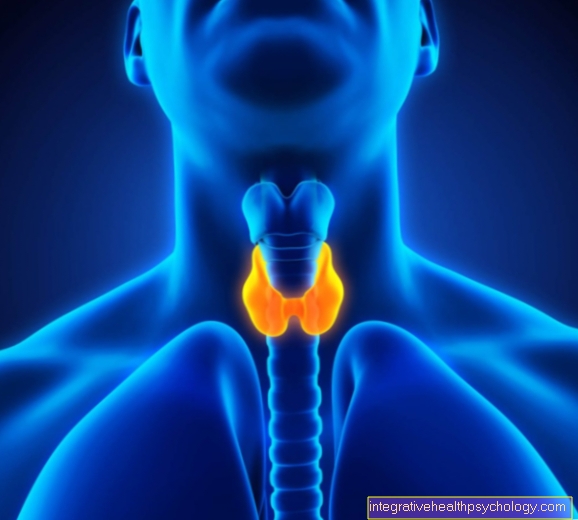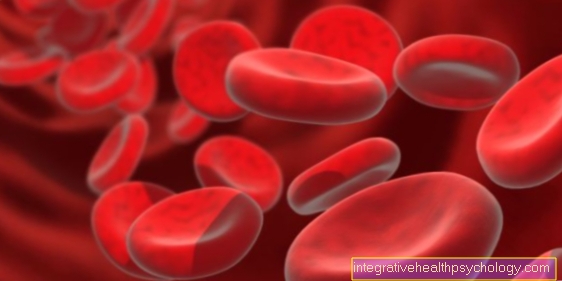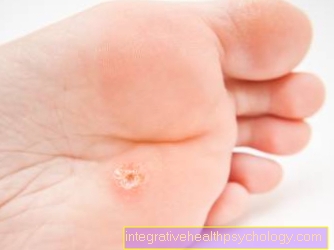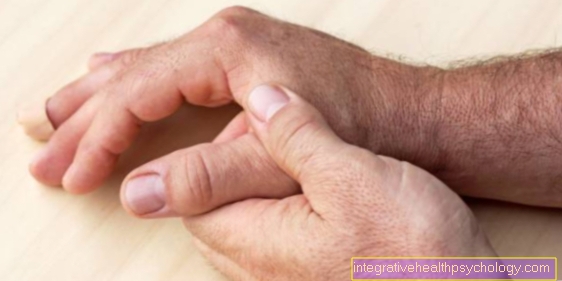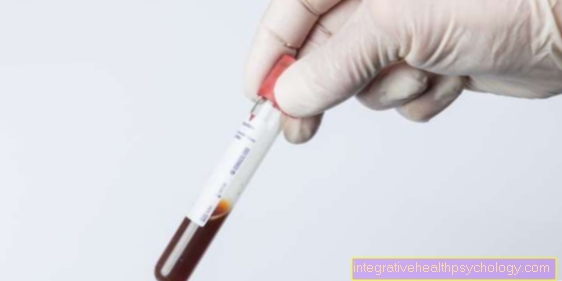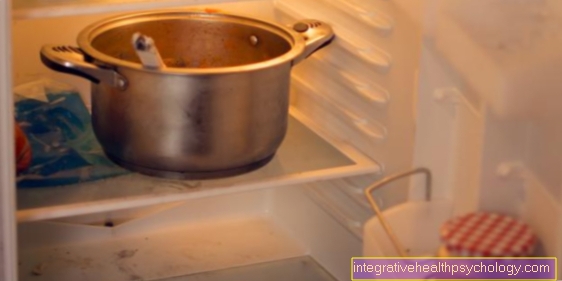EHEC - what is it?
introduction
The abbreviation EHEC stands for “enterohaemorrhagic Escherichia coli”.
This is a form of bacteria that can be found mainly in the intestines of cattle, sheep, goats, deer or roe deer.
The bacteria are able to produce various toxins, but these do not pose any danger to the animals.
If such toxins are transmitted to humans, however, severe gastrointestinal complaints can be caused.
In particularly severe cases, the bacteria can cause life-threatening intestinal infections.
In 2011, the EHEC pathogen spread rapidly and dangerously in Germany.
You can find out everything about the bacterium Escherichia coli here: Escherichia coli

What causes EHEC infection?
Many millions of Escheria Coli bacteria can be found in the human intestinal flora.
These bacteria are part of the natural intestinal flora, where they have important functions for the body.
The EHEC infections are triggered by a special strain of the bacterium Escheria coli (E.coli), which does not occur in the natural intestinal flora of humans. This special strain can only be found in ruminants, which can excrete the bacteria in the feces.
The causes of an infection are then contact with the bacteria via food, contaminated water, contaminated objects or, in the case of small children, direct contact with the animals.
So is the transmission route
The transmission path of the bacteria begins with the excretion of the bacterium in the faeces.
Enterohaemorrhagic Escheria coli can survive in the environment for a very long time and are therefore still contagious to humans even after several weeks.
A direct transmission path can be from animals to humans.
Since the animals can still be contaminated with a few traces of faeces, the EHEC pathogen can easily be transmitted through contact with the animals.
Playing in the meadows where the ruminants are kept is a source of infection, especially for children.
Another way of transmission can be through food.
If, for example, the vegetables are fertilized with the help of manure, the bacteria can be transferred to the food in this way and thus lead to a possible infection.
Insufficiently heated food or raw meat can also lead to an infection with the EHEC pathogen.
The bacterium can also easily be transmitted from person to person.
People who have been infected with the EHEC bacterium also excrete the pathogen through their stool.
Infection can also occur through touching the stool of an affected person.
However, in order for the bacterium to show its actual pathological effect on humans, the bacterium must get inside the body.
This usually happens when you put your hand in your mouth, as is often the case with children, or when the pathogen is transferred from your own hand to food, which then gets into the mouth and finally also into the stomach and intestines.
This transmission path can be prevented by hand disinfection.
How contagious is EHEC?
Since the EHEC bacterium can survive for several weeks outside of the animal's body, there is a high risk of infection and special care is required, especially in jobs that have a lot of contact with cattle, goats or deer.
Once the bacterium has entered your own body, it can usually only be excreted through your own stool.
Particular caution should also be exercised when consuming foodstuffs that have been fertilized with the help of liquid animal manure.
It is always important to clean it well before consumption.
In addition to being transmitted directly from animal to person or from person to person, the bacterium can also be transmitted through contaminated water.
This can get into the body of the person affected by drinking or bathing.
In general, the EHEC bacterium is very contagious compared to other bacteria.
Just 10 bacteria are enough to cause infection.
Duration of an EHEC infection
An EHEC infection can take on the most varied of dimensions and therefore the course of the disease can vary in length.
Sometimes it even happens that a person infected with EHEC does not feel any signs.
As a rule, the incubation period, i.e. the time between infection with the bacterium and the first signs of infection, is between two and ten days.
After the infection, the course of the disease takes on different dimensions.
Many sufferers initially complain of watery diarrhea and severe nausea.
Although this is extremely uncomfortable, it also promotes healing in the same way.
The diarrhea causes the bacteria to be eliminated from the body as quickly as possible, so that they cannot cause any further complications.
The diarrhea can last a few days to two weeks.
If the symptoms persist for more than two weeks and if there are other symptoms such as weakness, reduced urine output or a general tendency to bleed, it can be assumed that the EHEC bacterium has also brought another clinical picture, the hemorrhagic-uremic syndrome, with it .
This syndrome can take on drastic proportions with no treatment or treatment that is too slow.
In the worst case, lifelong damage and the associated dialysis obligations can be caused.
However, if the syndrome is discovered and treated quickly, it should be cured in a few weeks.
What is the course of the disease?
With an EHEC infection, the disease can take different courses.
Depending on the severity of the infection, it can rarely even be life-threatening.
The first sign of an infection is usually watery and often bloody diarrhea.
If such symptoms occur, a doctor should definitely be consulted.
In addition to diarrhea, there is often nausea and vomiting.
The vomit can also contain slight traces of blood.
In most cases, after a few days to weeks, these symptoms subside and the disease appears to be cured.
The infection can rarely cause other diseases, such as HU syndrome.
In this case, diarrhea and vomiting may subside, while other symptoms such as paleness, weakness and urinary retention occur.
If this is the case, the course of the disease is prolonged and can last up to several weeks.
In the most severe case, the HU syndrome can also cause persistent kidney failure, so that the person affected is dependent on external blood detoxification using dialysis for life.
incubation period
The incubation time is the time that elapses between the infection and the outbreak of the infection within the body.
It describes the time that the bacterium needs to develop its effects within the body.
In the case of an EHEC infection, the incubation period is two to ten days.
An average of three to four days are given.
The haemolytic uremic syndrome (HUS) caused by the EHEC infection shows the first signs after about a week.
The first symptoms of HUS only appear after the outbreak of the EHEC infection.
This is how you treat the infection with EHEC
There are different approaches to treating an EHEC infection.
Since enterohaemorrhagic Escheria coli are bacteria, antibiotic therapy can be considered.
This is generally only recommended in exceptional cases, as it would delay the excretion of bacteria.
As a result, the bacteria would have a longer time to release their toxins.
Treatment of the EHEC infection is therefore usually symptom-specific.
There are no direct drugs for the infection.
The aim is to remove the pathogenic bacteria from the intestines as quickly as possible, before they can cause more serious diseases.
Due to the high loss of fluid and nutrients, an intake of potassium, sodium and fluids is of great importance.
This supply usually takes place via infusions or tablets.
Treatment of the EHEC infection with the help of diarrhea medication is, however, absolutely not recommended.
Even if the diarrhea is an extremely uncomfortable situation, the pathogenic bacteria are eliminated through it.
If the EHEC bacterium has already caused the HU syndrome (hemolytic uremic syndrome), its symptoms must also be treated as soon as possible.
If there is no quick, specific treatment here, the haemolytic-uremic syndrome can lead to death.
The treatment involves stimulating the weakened kidney function with various drugs, for example diuretics.
If this treatment option is unsuccessful, dialysis must be used, as this is the only way to remove the toxins from the blood of those affected.
These symptoms show that you have an EHEC
EHEC infections in adults can often take place without any external signs.
The bacteria are then excreted again after a few weeks without any further symptoms.
In order to recognize an EHEC infection, however, various symptoms can be described.
The first signs of an EHEC infection are usually nausea and the resulting diarrhea.
Abdominal cramps and fever are also among the typical EHEC symptoms.
In individual cases, the EHEC infections are very severe.
In addition to the usual symptoms, severe intestinal inflammation also occurs.
Elderly people, infants and people with a compromised immune system are particularly sensitive to such levels.
In this case, those affected complain of severe abdominal cramps and bloody diarrhea.
Such intestinal inflammations are also known as hemorrhagic colitis.
In addition to the intestinal inflammation, the EHEC infection can also cause the so-called hemolytic uremic syndrome (HUS) in rare cases.
This is characterized by anemia and kidney weakness.
In this case, the EHEC toxins attack the blood cells, which eventually perish.
Hemolysis results in anemia (anemia).
If such a case occurs, those affected usually feel weak and pale in the face and extremities.
In addition, an increased tendency to bleed can be associated with the clinical picture.
There is an increased number of smaller bleeding or larger hematomas on the surface of the skin.
The HUS has other effects on the kidneys.
This can no longer properly excrete the water, which leads to water retention, especially in the legs.
Confusion and seizures can also be a rare side effect.
This is because the kidneys can no longer carry out their usual detoxification function.
diarrhea
Diarrhea is generally spoken of when the person has stool more than three times a day that is not in its normal form.
The diarrhea during an EHEC infection appears as watery.
In most cases, the amount of stool excreted exceeds the usual amount.
It is also true that diarrhea that lasts for over three days should be consulted by a doctor, as important nutrients are lost through frequent bowel movements.
Read more on the subject at: Diarrhea like water
Another typical feature of diarrhea in an EHEC infection is that little to a lot of blood can mix in.
The reason for this is that toxins are formed in an EHEC infection, which can damage blood vessel walls in particular.
This damage leads to bleeding in the bowel area, which is eventually excreted with the stool.
You can find out how to treat diarrhea with home remedies at:
Home remedies to treat diarrhea
Vomit
Infection with the enterohaemorrhagic Escheria coli (EHEC) bacterium can lead to watery, bloody diarrhea and severe vomiting.
However, this symptom does not always appear when compared to diarrhea.
Sometimes they only complain about a feeling of nausea.
If vomiting occurs, it may also contain a small amount of blood.
Since the toxins of the EHEC attack not only the intestinal vessels, but also the vessels in the stomach, this ultimately leads to bleeding, which has to get out through vomiting.
Also, check out what home remedies can be used to treat vomiting:
Home remedies to treat vomiting
What complications can arise?
The most serious complication that can be triggered by an enterohaemorrhagic Escheria coli infection is the haemorrhagic syndrome (HU syndrome).
The toxins of the EHEC bacterium attack the red blood cells, causing them to perish and leading to anemia.
In addition, the blood vessel walls and the platelets are severely impaired, which leads to an increased tendency to bleed.
These complications can be checked against simple symptoms.
The affected person feels very weak, tired and pale in the face and extremities due to the anemia.
Due to the damage to blood vessels and destruction of the platelets, there are also small and larger hematomas that have arisen without direct external influences.
In particularly severe cases, the kidneys are also impaired, so that little or no more fluid can be excreted through the urine.
This can cause two complications.
On the one hand, the blood can no longer be detoxified, so that one has to rely on external detoxification in the form of dialysis.
If the toxins cannot be excreted in the urine or otherwise, it can also lead to severe confusion or even seizures.
In addition, the reduced water excretion can lead to water retention, especially in the legs.
Is there a vaccination?
There is currently no general vaccination for the EHEC bacterium.
The manufacture of vaccines against enterohaemorrhagic Escheria coli is considered controversial.
This is due to the fact that the bacterium that causes the disease is constantly changing.
It still causes the same disease, but the genes change in such a way that a previously manufactured vaccine becomes useless and a new vaccine would have to be developed accordingly.
This is associated with high costs and does not promise any guaranteed effectiveness.
What is a permanent eliminator?
Permanent eliminators are people who, after infection with bacteria or viruses, continue to reproduce and eliminate them after more than ten weeks.
Those affected still excrete the bacteria or viruses even though the symptoms of the disease no longer appear.
Because the bacteria or viruses are still being excreted by the person affected, the stool or some of the vomit are still infected and thus contagious.
Particular caution is required when the disease progresses, as the person concerned is usually ignorant of the risk of infection.
This is how the diagnosis is made
If an EHEC pathogen is suspected, the person concerned usually presents to his family doctor because of severe diarrhea symptoms.
In order to finally be able to make the diagnosis of an EHEC infection, different examinations are carried out.
First, an examination of the stool sample is taken.
The stool sample may show blood in the stool.
If an EHEC infection is suspected, a special stool examination can also be carried out.
Another elucidation criterion for an EHEC infection can be a blood and urine test.
In addition to its actual effect, the EHEC infection can also cause a so-called hemolytic-uremic syndrome (HUS).
This can be detected by determining blood cells and platelets in the blood.
Changes in kidney values can also indicate impairment of the kidneys due to the EHEC infection.
A clear diagnosis can be made by determining the EHEC toxins.
The suspicious bacteria are carefully examined for their genes and poison production.


